NZXT E650, monitoring and customization on the program! Config Council | Specs | Price also check out the pros an cons as well as its specs and configuration.
It has been a long time since we had any NZXT products to test in the newsroom, since the H700i earlier this year. Today we are going to introduce you to the NZXT E650, the brand new power supply that wants to be “connected” as much as possible. NZXT had already tried power supplies in 2010 with its Hale 90s, excellent blocks but which had no consequences.
The new E series is made up of three new models, 500, 650 and 850 Watts, certified 80Plus Gold. Let’s take a closer look.
Presentation and bundle
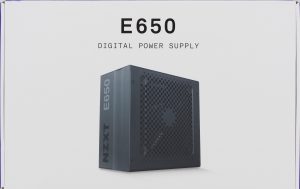
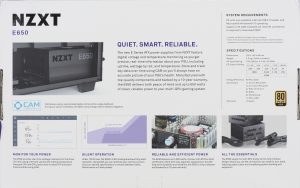
The box could not be more sober as usual with NZXT, there is on the front a photo of the block and the name of the model on a white background, and that’s it! At the back there is a listing of the strengths of the beast, namely consumption monitoring, hybrid ventilation, high-end internal components and so on. In addition to that, a table showing the distribution of power on the different rails and the number of connectors available, the union minimum!
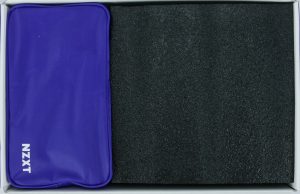

Inside the box we start to get an idea of the OEM who built the block, Seasonic of course! When opening, we therefore fall on a thick foam enveloping the block, a bag containing the various modular cables being right next to it.
The bundle could not be more restricted, with more modular cables only the manual, scratch point to attach cables or others.
Presentation
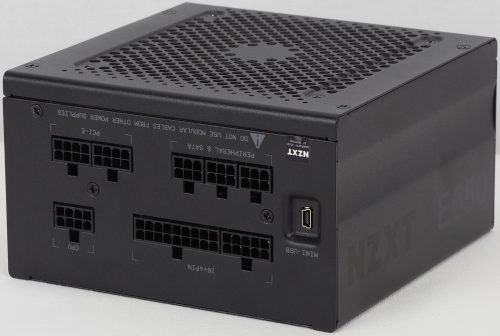
Here is the beast! One thing is certain, NZXT has done everything to offer us a product with high-end looks. The paint is perfectly applied, the finishes are excellent and the sobriety of the whole can perfectly match in all PCs. The dimensions are contained, with 15 cm of depth, which could be a criterion of choice in compact boxes.

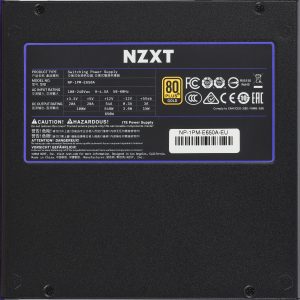
Above we find a ventilation grid that changes a bit from what we have on competing models, with circles of different sizes to give an atypical look. It hides the 12 cm fan installed by NZXT, even if its look is nice these holes are not the best for letting air flow through, although this will not change much in practice!
below, a sticker is present, showing the power distribution table, the 80Plus Gold label as well as the usage information.
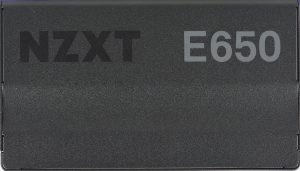
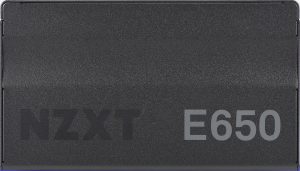
On the sides, sobriety takes precedence once again, with only the brand’s logo and the model, nothing that is not “flashy” here! However, NZXT made a rather questionable choice on the direction of the writing. Indeed, it does not matter whether we put the fan down or up, the writings will be in advance when we look at the block from the component side, when we have a window panel for example.
NZXT has chosen to have the inscriptions right side up when looking at the back of the motherboard, because all the brand’s boxes are equipped with a power supply cover and apparently all the boxes on the market take this trend. This is all well and good, but is the number of people with a power supply cover greater than those without, and who have a glass on the back side of the motherboard? 😉
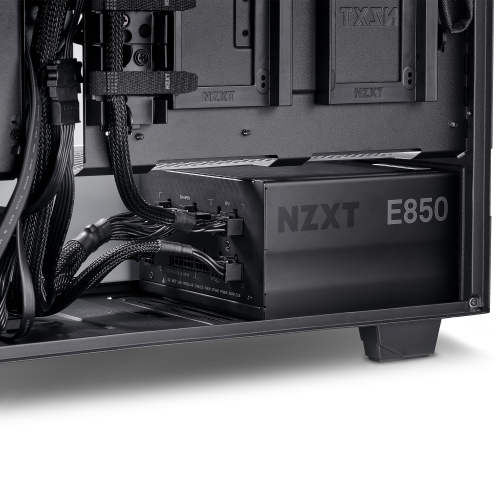
Here is what we are talking about here, the writing being in the right direction when looking from the back of the motherboard, is up to you to get an idea on the choice of the manufacturer 😉
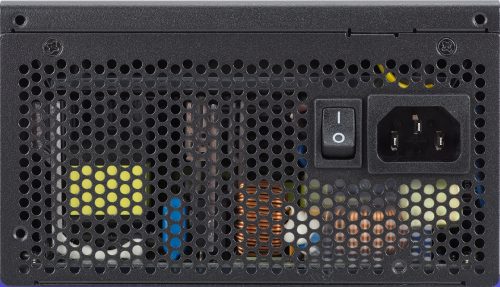
At the rear a large perforated grille is present to allow the air flow to pass, which shouldn’t be huge anyway ???? Push button point to switch from hybrid mode to active mode, yet present on the Seasonics. In addition to this of course the mains connector and the on / off button are present.
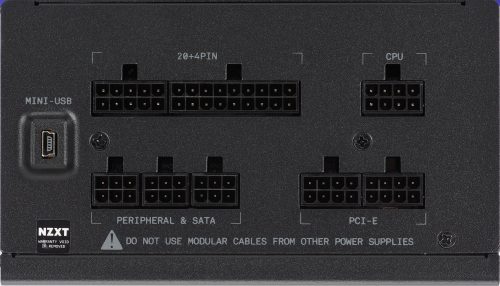
On the connector side we find the 24-pin and CPU 4 + 4-pin, as well as three connectors for Sata / Molex devices and two for PCI-E. Also and more atypical a mini-USB port is present, a cable is delivered in the bundle to connect the block to the motherboard, in order to monitor the beast.
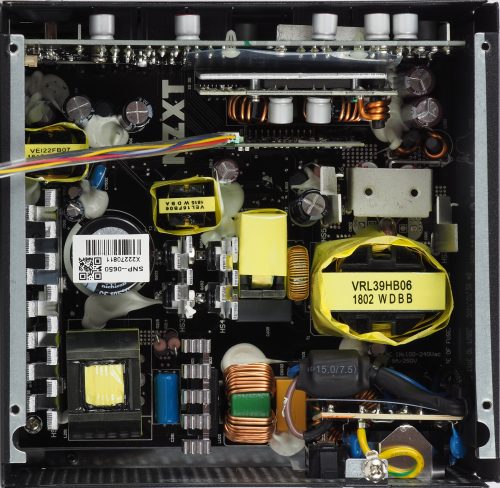
Once the NZXT E650 exposed, we come across a platform that we know well now, the Seasonic Focus + Gold! Of course, a few changes have been made to allow consumption monitoring in real time, as well as a few other things that we will see below. The capacitors are as usual high-end with Japanese models certified 105 °, which will ensure increased reliability.
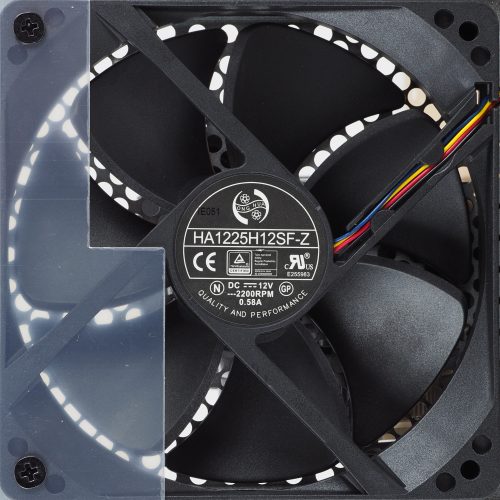
The fan is entrusted to Hong Hua with its model HA1225H1S2F-Z rotating at a maximum speed of 2220 RPM for a given consumption of 6.96 Watts (maximum), a “FDB” model ensuring lower noise than a ball bearing while keeping a very long lifespan. So no worries at this level either, anyway the 10-year warranty is there if ever the fan were to cause concern ???? Note that even if it is given to operate at 2200 RPM, NZXT ensures a maximum speed of 1800 RPM, most certainly managed by the internal electronics.
Modular cables
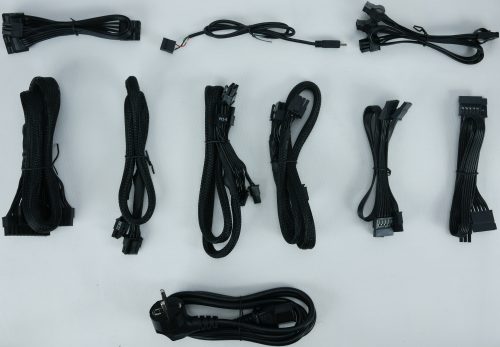
| NZXT E650 | |
|---|---|
| 24 pine | 61 cm |
| 4 + 4 pin (Processor) | 65 cm |
| 6 + 2 pin (Pcie) + 6 + 2 pin (Pcie) | 67.5 + 7.5cm |
| 6 + 2 pin (Pcie) + 6 + 2 pin (Pcie) | 67.5 + 7.5cm |
| Sata + Sata + Sata + Sata | 50 + 10 + 10 + 10 cm |
| Sata + Sata + Sata + Sata | 50 + 10 + 10 + 10 cm |
| Molex + Molex + Molex | 50 + 10 + 10 cm |
| Mini-USB -> USB 2.0 connector | 60 cm |
The number of cables is largely sufficient for a classic configuration. Indeed, with 4 PCI-E connectors, 8 x Sata and 3 x Molex it will be difficult to fault the NZXT E650. As with other power supplies based on the Seasonic Gold + platform the 24-Pin, 4 + 4-pin and PCI-e cables are sheathed, the others are flat. Whether you like sheathed cables or not, they are there and you will have to do with 🙂
Characteristics
| NZXT E650 | |
|---|---|
| Power | 648 Watts for + 12V 100 Watts for + 3.3V and +5 V combined 15 Watts on + 5Vsb 3.6 Watts on -12V |
| 80Plus certification |  |
| Maximum yield | 90% / 92% / 89% at 20% / 50% / 100% load |
| Fan | Hong Hua HA1225H12SF-Z |
| Sound level | 32.3 dB Maximum |
| Modularity | 100% modular |
| Protections | OCP, OVP, UVP, SCP, OPP, OTP |
| Number of 12v rails | 1 of 54A |
| Dimensions | 150 x 150 x 86 mm |
| Format | ATX |
| Weight | 1.6 kg |
| Operating temperature | 0 -> 50 ° |
| Guarantee | 10 years |
| Recommended price | € 129 |
As with all modern minimum correct power supplies, the 12V rail is able to provide (almost) all the power for which the block is sold, namely 648 Watts! There is no accumulation with the other rails to give us a power that is not really what we might expect, as we have only seen too much in the past. The 80Plus Gold certification allows an efficiency capable of reaching 92% to 50% of the block load, 90% to 20% load and 89% to 100%, which means that the efficiency is very good.
The dimensions of the block are contained, even if the length takes 1 cm compared to the Seasonic of the same power, arriving at 15 cm, which is in any case nothing very huge and the E650 should be compatible with almost all ATX cases on the market.
Offered at a recommended price of around 130 €, from a purely technical point of view it is difficult to justify this, when you can find a Seasonic Focus Gold + at 100 €. The NZXT E650 will have a lot to do with software with its 30 € difference.
The software
As we said above the NZXT E650 allows monitoring of its voltages, internal temperature and other features, via the CAM software. To download the beast you can go here. We will go around the owner.
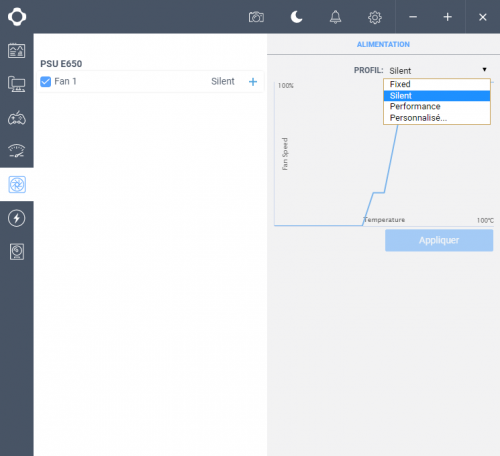
In CAM we therefore have two parts reserved for food. The first is ventilation management. Here it is possible to adjust the fan according to several presets, “Silent” for fans of silence, “Performance”, “Fixed” (fan fixed at a certain%) or even personalized. We can applaud the gesture but whether it is in silent or personalized mode the fan will start working no matter what once the internal temperature reaches 50 °. Quite frankly, we have some doubts as to the usefulness of this.
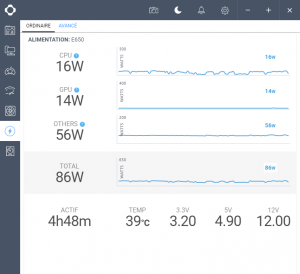

Just below we have what interests us the most, monitoring! In the program in the “Ordinary” part (very well translated as you can see!) The consumption in real time of the processor, the GPU, the other components as well as the total of the machine. In addition to this the internal temperature is displayed as well as the voltages.
Note that the consumption displayed comes only from what is “pulled” from the cables, for example for the graphics card there is no consumption of the PCI-E port itself (which can rise to 75 Watts), which is classified under “Others”.
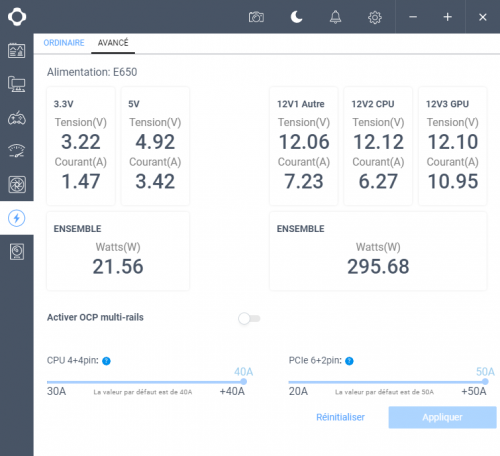
The “Advanced” tab displays the voltages, as well as a switch allowing the block to be switched from mono to multi-rails, the interest being very honestly limited with a block of this “low” power. Nevertheless, once activated we can set the maximum value before blocking the block, whether it is CPU or PCI-E.
The tests
The test platform
The NZXT E650 power supply has been tested on the configuration below:
- Processor : Intel Core i7 875K @ 3.2 Ghz
- Motherboard : Asus P7P55D
- Memory : Kingston HyperX 4 x 2 GB 1600Mhz
- Hard Drive: WD Raptor 150 GB
- Graphics card : Sapphire Toxic 5850
The test protocol
The core i7 875K has been slightly overclocked to 3.2Ghz. The supported readings were taken at the outlet during a 100% CPU and graphics card load, the idle readings were taken after 15mins on the desktop.
Before starting, let’s take a look at the performance of the power supplies compared to our block, in fact the various 80Plus certifications will directly influence consumption, so this will be a good way to have concrete results. Only the FSP Hyper M 500 does not have an 80Plus certification.
The consumption

As we can see the consumption is in the nails of the 80Plus Gold block of the comparison. Indeed, with 72 Watts at rest for 348 Watts in load, the NZXT is at the same level as the Seasonic Focus Plus Gold, its twin sister (in 550!). The Corsair RM750i which is its direct competitor also offers us the same performance.
Note that the consumption has been recorded at the outlet and for the complete configuration , in load for example and on the 348 Watts “drawn” at the outlet, the components only consume between 315 and 325 Watts of the 650 Watts available, the power supply is therefore clearly not pushed to its limits, but it represents a good “gamer” configuration these days.
The tensions

It’s hard to find anything to say about the tensions as well. The Seasonic Focus Plus platform is really stable and there is really nothing to criticize. The 12V goes from 12.12V at rest to 12.11V in charge, the 5V from 5.05 to 5.04V and the 3.3V from 3.33 to 3.34V. The only way to make it more stable would be to go on a very high-end block, like the Seasonic Prime for example which does not flinch a bit whether at rest or in charge. However, with barely 0.01V of difference on all voltages your components are perfectly protected and there is no risk on the length 🙂
Noise pollution
Warning: Part to be taken with a grain of salt, unfortunately not having access to the appropriate equipment and using an android application to take the readings The measurements below are only indicative! The readings were taken 15cm from the feed.
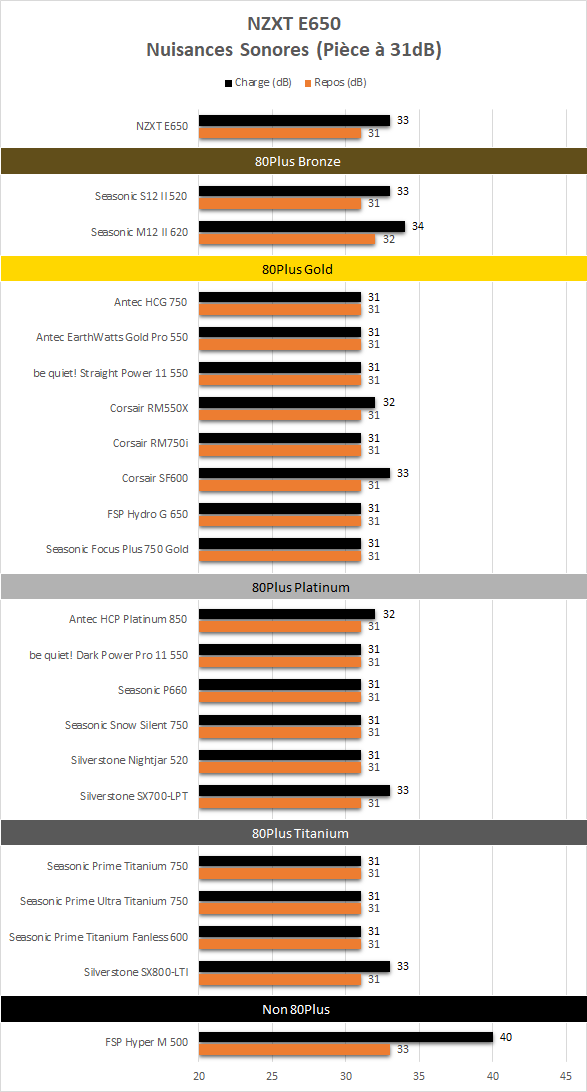
The block from NZXT continues with its good sound performance. Indeed, at rest the unit works in passive mode so you simply hear nothing, not even a “coil whine” which some (including me) hate so much! Once charged, the sound level increases very slightly to reach 33 dB, which means that unless you have your ears really glued to the NZXT E650 you will simply not hear anything once installed in a box.
It is also necessary to take into consideration that once in load you will hear your graphics card or the cooler of your processor much more than the power supply.
There is a small increase in noise level compared to the Seasonic Focus Plus block, but we can blame that on the ambient temperature of over 30 ° here, which clearly doesn’t help.
Conclusion
Here we are at the end of this test, what about the NZXT E650 power supply?
NZXT returns to the power supply market with a model that needs almost a flawless one. Indeed, the brand has turned to one, if not the best manufacturer on the market, Seasonic with its Focus Plus Gold platform. From there we have results in practice which are excellent, whether in terms of voltages, consumption or even sound level, we can go on with our eyes closed.
The build quality is also excellent, NZXT has always made a point of offering quality products, and the E-series power supplies are not here to change anything.
However, we find a somewhat odd decision coming from NZXT with the inscriptions oriented to be right side up when looking at the case on the back side of the motherboard. Even though there are more and more boxes with a power supply cover, who is looking the other way? In short, it is not very important either, but those with a window without bezel will have the NZXT E650 upside down.
Offered at a price of 130 € the NZXT E650 is at the level of its competitor Corsair RM650i, despite everything it is 30 € more expensive than its twin sister Seasonic Focus Plus Gold 650. This in the end is equivalent to paying 30 € more just for the monitoring on the CAM software, it’s up to you to see if it’s worth the increase .
As always if you are looking to build a gaming or office PC, don’t hesitate to come and ask me on the forum, it is there for you!















